 © Stefan Gloede Musikfestspiele Sanssouci
© Stefan Gloede Musikfestspiele Sanssouci
David et Jonathasby Marc-Antoine Charpentier thrills at the Musikfestspiele Potsdam Sanssouci
French Baroque at its best
The French just know how to do it ... in this case, it is both an opera from 1688 and the production, including costumes and stage design. No wonder ... this is a co-production with the Opéra Royal/Château de Versailles Spectacles with the Musikfestspiele Potsdam Sanssouci and first shown in Versailles in November 2022.
David et Jonathasis a five-act opera by Marc-Antoine Charpentier, one of the leading composers in French Baroque. With a libretto by François de Paule Bretonneau, it is based on the biblical story of David and Jonathan from the First Book of Samuel in the Bible. Incidentally, George Frideric Handel chose this theme for his oratorio Saul, too.
The story is about the deep friendship between David, the future King of Israel, and Jonathan, the son of the current King Saul. David is being held captive in King Saul's court. Saul's son Jonathan is attracted to David and the two become friends. Saul is suspicious of the growing relationship between the two and believes David wants to seize his power. Jonathan swears his friendship and loyalty to David, despite his father’s misgivings. Meanwhile, a sorceress - here called Phythonisse - prophesies Saul's death and David's rise to power. Saul tries to kill David, but Jonathan saves his friend and lets him escape. Saul is furious with his son and orders him to pursue and kill David. David is hidden in the desert and Jonathan comes looking for him. They reaffirm their friendship and Jonathan promises to protect David. Saul and Jonathan die in battle. David mourns his friend and takes his place as King of Israel. He promises to avenge Jonathan's death by becoming a good king for his people.
Director Marshall Pynkoski has the opera take place during the period of its creation in the second half of the 17th century, emphasising the ritual order and sense of pomp and solemnity that permeate large parts of the work. He is supported by Jeannette Lajeunesse Zingg's historically informed choreography, which understands that here the dances are not just decorative movements but part of the action and actively involved in moving the story forward. Through Charpentier's powerful rhythms and flowing melodic lines, the chaconne, bourée, gigue and minuet naturally are naturally set by the choreographer and are performed by the wonderful dancers of the Ballet de l'Opéra Royal du Château de Versailles. Both the dancers and the soloists look enchanting in their sophisticated costumes, all based on the historical models of the French Baroque in the time of the Sun King Louis XIV and interpreted here by the world-famous haute couture fashion designer Christian Lacroix.
The simple stage design - a stylised tower with a gallery to which stairs lead left and right and a long, red canopy that is used in different ways - by Antoine & Roland Fontaine fits seamlessly into the beautiful neo-Gothic brick building of the Church of the Redeemer in Potsdam, which contributes to the listening pleasure with its excellent acoustics.
At the forefront of this listening pleasure is the David of Haute Contre David Tricou. With his well placed intonation, warm and pithy timbre, he embodies a David for whom human relationships are more important than political power. His friend Jonathas is equally convincingly cast by soprano Caroline Arnaud. Baritone David Witczak embodies his father, King Saul, who loses his royal dignity in the course of the evening and is torn apart by feelings of hatred and self-doubt. The supporting roles are also excellently cast: tenor François-Olivier Jean as the fortune-teller is a fearsome figure thanks to the pompous, almost grotesque costume. Tenor Antonin Rondepierre is Joabel, the scheming commander-in-chief of the Philistine troops, who incites David to war with an almost whining tone and body language to match. As a counterpart is Achis, sung with great dignity by bass Cyril Costanzo, who pleads for peace. The deep bass of Nicolas Certenais comes up from dramatic depths in his role as Samuel's shadow appearing from hell to put fear in Saul’s heart.
Charpentier's music adds emotional richness and depth to this story, as well as fine character drawing. and presents it in a series of dramatic arias and choruses. It explores the potential conflicts of love, friendship, loyalty and political power. The opera ends with David's passionate lament over Jonathan's death, which underscores their unwavering friendship and love for each other. These many, diverse facets are finely crafted by the chorus and orchestra of the French Ensemble Marguerite Louise led by its founder and director, Gaétan Jarry. In his time, Charpentier, was held back by the reigning court conductor of the time, Jean-Baptiste Lully. But he is definitely a composer from whom one wants to hear more. Jarry makes the many orchestral colors shine with a delicate freshness and tempi that are anything but boring. Coincidentally, a thunderstorm with thunder and lightning broke out in the middle of a battle scene, reverberating in the church and adding just the right atmospheric touch.
This exceptional opera at the Potsdam Sanssouci Music Festival was rightly celebrated frenetically by the audience in the almost completely sold-out hall.
Zenaida des Aubris
the 20 of June, 2023 | Print
Comments